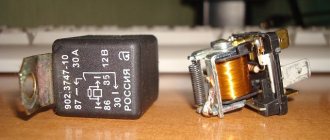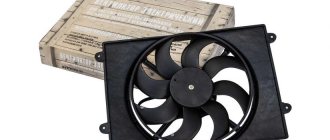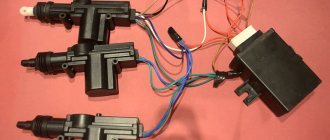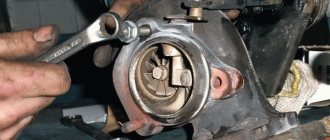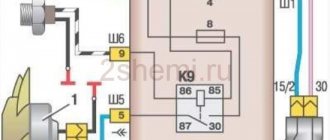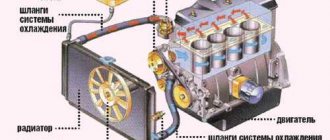As you know, fuel combustion occurs during operation of a car engine. This generates a large amount of heat as part of the conversion of thermal energy into mechanical energy. In this case, excess heat must be removed from the internal combustion engine to the external environment to prevent overheating of mechanisms and parts.
The engine itself should not overheat above the optimal 80-90°C. For this purpose, special devices are used, which together form a cooling system. Cooling systems are also divided into two types: liquid and air. In modern cars, these two types of systems are combined and are hybrid.
Although the liquid system is considered to be the main one, air cooling also deserves special attention, without which, under certain conditions, the car engine will inevitably overheat. Let's look at the air cooling system and its malfunctions in more detail.
Operating principle of radiator fan
Before considering this issue, let us discuss in general what the water cooling system of an internal combustion engine is, shown in the figure below. It will allow us to remember the principle of its operation.
In cases where cold liquid passes through the motor jacket, it picks up excess heat, while the engine cools and the water heats up. Then it passes through the radiator, where it releases the resulting heat into the atmosphere, and again enters the engine.
The radiator design is a set of thin tubes that create a large cooling surface. The incoming air flow, passing through it, carries away excess heat that is stored in the liquid. In cases where there is no incoming air flow (engine idling, traffic jams and other similar situations), or it is not enough to cool the water to the desired temperature, the cooling radiator fan is provided for.
For this purpose, there is a special control circuit, the basis of which is the thermal switch of the radiator fan. It controls the temperature of the liquid. When it exceeds the established limits, the sensor is triggered and, based on its signal, the radiator fan is turned on, which creates the necessary air flow. This flow cools the heated water, and when its temperature reaches the required value, the sensor is triggered again and turns off the blowing.
This is how you can describe the basic principle by which the radiator fan works - it turns on when the water temperature exceeds the set temperature, and turns off after it drops to the desired value.
Electrically driven cooling fan
The fan electric motor is powered from the vehicle's on-board power supply. Existing solutions can be divided into:
- fan with thermal switch;
- fan with electronic unit;
Cars at an early stage did not have electronic control units. The electric motor of the cooling system fan was activated and turned off by a thermal switch, which some car enthusiasts confuse with a temperature sensor. The temperature sensor is often built into the engine block housing. The signal to the dashboard in the cabin comes from it, since temperature control near the combustion chamber is much more important than the coolant temperature.
The thermal switch is similarly activated when the temperature rises, but relies on the readings of the coolant temperature sensor in the radiator. The device operates in a narrow temperature range. For example, the fan is activated at a coolant temperature of 85 degrees Celsius, and it will turn off at 70 degrees. The principle of operation of the device is quite simple. If the temperature rises above a predetermined threshold, then the contacts in the thermal switch close, which will lead to the closure of the cooling fan power supply circuit. Current is supplied to the electric motor and the impeller begins to rotate. Reducing the temperature to the minimum threshold will cause the contacts to open and the fan will stop working.
It is noteworthy that the design of the electric fan drive with a thermal switch can be installed on almost any motor. The fan control circuit is noticeably more complex in modern models with an ECU and includes a number of elements and actuators, including the main ones:
- coolant temperature sensor;
- ECU;
- fan relay;
- electric motor;
The temperature sensor measures the temperature of the coolant in the power unit. Modern cars can have two sensors at once, which are installed in different places. One temperature sensor is placed at the outlet of the engine or in the thermostat housing, the other is placed in the pipe at the outlet of the radiator. The fan is controlled taking into account the readings of both elements and subsequent assessment of the difference in the data received from the sensors. For more efficient control, additional devices are also used, among which it is worth noting the crankshaft speed sensor and air flow meter. The readings of these sensors are necessary to accurately determine the mode in which the engine is operating at a certain moment.
A set of signals from the sensors is transmitted to the engine ECU, which analyzes them and activates the fan relay at the right time. The fan works exactly as much as is necessary to achieve the optimal temperature indicator in relation to a specific speed mode and load on the internal combustion engine.
Car models that have an air conditioning system often receive two fans at once. Each of these fans has a separate switching circuit. Fans can operate synchronously or separately, which will directly depend on the temperature and operating conditions of the internal combustion engine. The fan switching relay is gradually replacing the dedicated fan control unit for maximum effective control of its operation.
There is also a function where the fan is automatically turned on after the engine is turned off. This is necessary to prevent the temperature in the cylinder head from rising too sharply immediately after stopping the heated engine, since as a result, the circulation of coolant in the system immediately stops.
What are the consequences if the radiator fan does not work?
An internal combustion engine is a complex device, and its performance is optimal when it operates at a certain temperature. As noted above, it depends on the correct operation of the cooling system. In the case when it is not possible to maintain the required temperature, the consequences will be quite sad - if the engine overheats, it may well jam and then, at a minimum, a major overhaul is guaranteed.
The stability of the entire system should be created by a fan, allowing the water temperature to be reduced in any conditions. But if it doesn’t work, especially when it’s hot, then you need to look for why the fan doesn’t turn on or doesn’t spin. Nowadays, such devices are usually electrical, and failure of the product itself is unlikely, and a possible reason for this is often the failure of its wiring (sensor, fuse, connecting wires, etc.).
This means that when figuring out the reasons why the radiator cooling fan is constantly running or why it doesn’t turn on or spin, you must first check the wiring of the device.
How to check a radiator fan
As we have already established, the radiator fan should turn on when the temperature of the water (antifreeze) exceeds the set value. This can be checked by the instrument readings on the front panel. If the fan does not turn on, then it is necessary to check the entire signal chain.
- Check the presence of supply voltage coming to the product. To do this, you can use a tester or a light bulb. The absence of voltage will indicate a possible blown fuse or poor contact in the wires.
- The serviceability of the fan itself can be checked by applying voltage to it directly from the battery. If it spins, then everything is fine with it, and the defect must be looked for in other devices. If not, and the fan does not spin, then this is the cause of the defect. In principle, you don’t have to stand still and move on, but you must constantly monitor the engine temperature. When the arrow approaches the red sector, you need to stop, open the hood and cool the engine. Two techniques will allow you to move in this case too. Maintain a speed of at least sixty km/h, then the constantly flowing oncoming air will cool the water passing through the radiator, and you will be able to drive as usual as long as you maintain speed. Another technique that allows you to partially replace a non-working fan is to use heating. Turn the stove to maximum heating mode, in this case some of the excess heat will escape through the heater. True, the cabin will be like a bathhouse, but you will be able to get to the nearest service station.
- To check the sensor, you need to disconnect the wires from it and short them together. If the fan turns on and spins, it means that the sensor itself is not working; it cannot be repaired, only replaced. However, if you leave the wires closed, you can move on; with this option, the fan spins constantly, although it is possible that the engine temperature will be lowered, but this is better than standing still.
What to do if the cooling fan is constantly running
When the engine cooling fan runs constantly, you should look for the problem by doing a few simple diagnostic steps. The check must be performed sequentially, based on the most probable causes.
Radiator cleaning
- Check for errors in the ECU memory . For example, error code p2185 indicates that there is no “minus” on the DTOZH, and a number of others (from p0115 to p0119) indicate other malfunctions of its electrical circuit.
- Check the integrity of the wires . Depending on the design of the motor, individual wires associated with the fan drive may be damaged (usually the insulation is frayed), causing a short circuit. Therefore, you just need to find the place where the wire was damaged. This can be done either visually or using a multimeter. As an option, insert two needles into the contacts of the chip and close them together. If the wires are intact, the ECU will display an engine overheating error.
- Check the DTOZH . When everything is in order with the wiring and power supply of the sensor, then it is worth checking the coolant temperature sensor. Along with checking the sensor itself, you also need to check the contacts on its chip and the quality of fixation of the chip (whether the ear/clamp is broken). If necessary, clean the contacts on the chip from oxides.
- Checking the relay and fuse . Check whether power is coming from the relay to the fan using a multimeter (the contact number can be found in the diagram). There are times when it “sticks”, then you need to change it. If there is no power, you need to check the fuse.
- Cleaning radiators and cooling systems . If the main radiator or air conditioner radiator is covered with debris, they need to be cleaned. A blockage in the engine radiator can also form inside, then it is necessary to clean the entire cooling system with special means. Or dismantle the radiator and wash it separately.
- Check the operation of the cooling system . The fan can operate continuously when the efficiency of the cooling system and its individual elements is low. Therefore, it is advisable to check the cooling system, and if any breakdowns are detected, repair or replace its parts.
- Checking the freon level and the operation of the refrigerant pressure sensor . To carry out these procedures and eliminate the cause, it is better to visit the service.
- Checking the ECU is a last resort when all other components have already been checked. In general, the control unit must be dismantled and its housing disassembled. Next, check the condition of the internal board and its elements, and if necessary, clean it with alcohol to remove antifreeze and debris.
In summer, driving with the fan constantly on is not advisable, but it is acceptable. However, if the fan spins constantly in winter, it is recommended to diagnose and repair the breakdown as quickly as possible.
Radiator fan runs constantly
This case is partially discussed above; the cause is a failure of the temperature sensor or a short circuit in the wires going to the fan. But if it is constantly spinning, then this may be caused by a stuck relay. This happens quite often, especially after the relay is triggered and the fan should turn on. Sticking relay contacts mean that they cannot open, which causes a constant voltage supply to the contacts, causing the electric motor to spin constantly. The consequences of sticking relay contacts include the fact that the radiator fan does not turn off.
Often the thermostat may be the reason why the fan shutoff does not work . The fact is that the sensor is located in the head of the unit; it determines when the fan should turn on. But the coolant can move in a large and small circle; when it moves in a small circle, it does not enter the radiator for cooling. The mode of water movement is determined by the thermostat.
If it is jammed in the position of water moving in a small circle, then it will continue to move and overheat, which will trigger the sensor and turn on the fan, but because... water does not enter the radiator, it will not cool, and the sensor will constantly signal a high temperature. As a result, the radiator fan does not turn off. This case can be determined simply - you need to touch the hoses going to the radiator. When the thermostat is stuck, they will be cold if the engine is overheated.
If the radiator fan does not turn off due to a jammed thermostat, then sometimes you can knock on the case to eliminate this phenomenon. Often this is enough and the defect disappears. If everything remains unchanged, then you will have to remove the thermostat, take out all the stuffing from it and then put the device itself back in place. Another option for the same defect would be the thermostat getting stuck in an intermediate position. This can also result in the radiator fan not turning off, but this situation is much more difficult to diagnose. Such difficulties are caused by the fact that a certain amount of water enters the radiator, but too little of it passes through, all the water does not have time to cool, which leads to overheating of the engine.
All of the above is not a complete description of the possible reasons why the radiator fan does not turn off. There can be many of them, sometimes quite strange and unexpected, but in each of these manifestations of malfunctions it is necessary to look for the reasons and conduct a thorough analysis.
Engine cooling fan design
Structurally, a fan for cooling a car engine is a simple mechanism consisting of a pulley on which blades (impeller) are located. They are installed with a certain angle of inclination relative to the plane of rotation, which improves their aerodynamic characteristics and increases the intensity of air injection. The number of blades (from 4 or more), as well as their geometric dimensions (fan diameter, frequency of location) depend on the car model and are selected individually.
Modern cars are equipped with a so-called combined cooling system, which consists not only of a fan, but also has a radiator and special circuits (lines) with coolant. That’s why the engine “cooler” is often called a radiator fan.
Some vehicle configurations may use dual engine cooling fans, which have two pulleys with independent blades. They can be brought into operation simultaneously or separately, since each has its own connection system.
Engine cooling fan location
When the pulley rotates intensively, the air flow is “sucked in” from the outside using the blades. This increases the volume of air passing through the radiator, which ensures its more efficient operation and accelerates the process of heat removal. To force the rotation of the pulley (blades) and provide the required speed, several types of drive can be used:
- mechanical;
- hydromechanical;
- electric.
How does a mechanical drive work?
The simplest type of fan drive for cooling an engine radiator is based on transmitting rotational motion from the crankshaft using a belt. This method is completely mechanical and permanent, ensuring the start of the “cooler” synchronously with the operation of the engine.
Despite the simplicity of the design, such a drive reduces the useful power of the motor, since part of the energy is spent on pumping air. In addition, there is no possibility of adjusting the intensity of the blades. Due to these features, mechanical drives are practically not used in modern cars.
Features of the hydromechanical drive type
For more efficient operation of the engine cooling system fan, a hydromechanical drive type is used. Its peculiarity is that the blades are connected to the pulley through a sealed coupling. It can be of two types:
- viscous (viscous coupling);
- hydraulic.
The main task of the clutch is to start the radiator cooling fan when the engine load increases. When the engine operates at low speeds, forced air injection does not occur. A viscous or viscous coupling is connected to the engine crankshaft. Inside it is a silicone liquid (gel) that reacts to temperature. When the coupling is heated, the gel changes its properties and blocking occurs. In a hydraulic coupling, locking is achieved by changing the oil volume.
Electric and electromagnetic drive
In addition to viscous and hydraulic couplings, an electromagnetic coupling can be used in the radiator fan drive system. It reacts to the temperature of the coolant, maintaining it in the range of 80-85°C. Electromagnetic couplings are installed mainly on freight vehicles and construction equipment.
Electric cooling fan
This design consists of an electromagnet mounted on the fan hub. The latter is connected to the armature using a leaf spring and performs rotational movements. At temperatures below 80°C, the armature is outside the electromagnetic coil and the fan is turned off, but if the temperature rises above 85°C, the thermal sensor is triggered, closing the contacts and turning on the electromagnet. The armature is pulled into the coil and the fan is set in motion.
The most popular type of drive for modern cars is electric. It involves installing an additional electric motor in the system. Its operation is controlled by a control unit, which actually starts the fan when necessary. Just like for the electromagnetic clutch, the on and off mode is determined by the temperature of the coolant, which is recorded by a temperature sensor.
The advantage of using an electric motor to start the cooling system fan is the ability to implement a controlled fan run-out. In practice, this means that the airflow can continue even after the car's engine is turned off, speeding up its cooling.
Radiator fan turns on early
The other extreme is the situation when the fan turns on early. In this case, you need to look again at the temperature sensor. Most likely it needs replacing. If, of course, you have the right sensor. The fact is that sensors are designed for different temperatures; they are also called summer and winter; each of them must turn on in its own temperature range. The latter work later. And if you have been using these all the time, then it may seem to you that the fan turns on early, although it is done on time and everything works correctly.
We need to really evaluate how early everything happens. If early switching is set according to the readings on the instrument cluster, then this is not an indicator. However, when such inclusion causes concern, connect the appropriate equipment via the diagnostic channel and look at the actual thresholds of the sensor.
Cooling the car engine is the most important task. If you allow the engine to overheat, then at best it will need a major overhaul. The ability to operate a vehicle in any conditions is ensured by the reliable operation of the cooling system, which is largely determined by the correct operation of all its components.
What else is worth reading
Engine overhaul
How to flush the cooling system
Fuel pump fuse
Replacing the coolant pump
KAMAZ hydraulic coupling design
The hydraulic coupling has a simple design. Its basis is a drive wheel, made in the form of a torus (“donut”) cut along the torus, and connected to the casing by means of several bolts. The casing itself is rigidly mounted on the drive shaft, which, in turn, is mounted on the rear wall of the coupling using a bearing. The drive shaft has a splined connection with the clutch drive shaft, which plays the role of an intermediary between the clutch and the crankshaft. From the outside, the annular pulley hub and the generator drive pulley itself are attached to the drive wheel.
Inside the casing there is a driven wheel, which is also a cut torus, with its flat side turned towards the drive wheel. The inner surfaces of both wheels, which have a toroidal shape, have blades located along the radius. The wheels are solid cast (with blades), which significantly increases their reliability and strength. There are 33 blades in the drive wheel of the clutch, and one less in the driven wheel. There is a small gap between the wheels, which is necessary for the supply and removal of oil. The space between the wheels and their internal surfaces turned towards each other form the working cavity of the hydraulic coupling.
A driven shaft is rigidly connected to the driven wheel, which is passed through a hole in the center of the drive wheel and through the pulley hub, and ends at the fan hub. The fan impeller is mounted on the hub using bolts and can be removed if necessary. The driven shaft rests on one bearing located inside the pulley hub, the second support is a bearing in the casing.
The entire assembly is mounted in the front cover of the cylinder block, the fluid coupling is located on the same axis with the engine crankshaft. The generator drive pulley and the fan hub extend from the outside; on the inside, the fluid coupling is closed by a cover in which a bearing is mounted that holds the drive shaft (therefore, this part is often called the fluid coupling bearing housing).
The regulator-switch also has a simple device. Its basis is a housing, inside of which there are oil channels, a spool-type valve and a thermal power sensor that changes its length depending on the temperature. This unit is installed on the right cylinder block, on the inlet pipe (through it, coolant is supplied to the water jacket, in this place it has a minimum temperature), while its oil channels are connected to the main oil line of the engine (which is directly connected to the discharge section of the oil pump ) and oil channels in the block and in the fluid coupling bearing housing.
The fluid coupling and the regulator-switch always work together and only in extreme cases require driver intervention.
